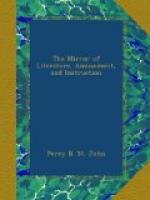The third division of the organ is the internal ear, which is called the labyrinth; it is divided into the vestibule, three semicircular canals, and the cochlea: the whole are incased within the petrous portion of the temporal bone. The internal ear may be considered as the actual seat of the organ; it consists of a nervous expansion of high sensibility, the sentient extremities of which spread in every direction, and in the most minute manner; inosculating with each other, and forming plexus, by which the auricular sense is increased. Here, also, sound is collected and retained by the mastoid cells and cochlea. To this apparatus is added the presence of a fluid, contained in sacs and membranes; as this fluid is in large quantities in some animals, there is no doubt it is intended as an additional means for enforcing the impression: the known influence of water, as a powerful medium or conductor of sound, strengthens this idea. The internal ear of man, therefore, has all the known varieties of apparatus, which are only partially present in other classes of the creation; and its perfection is best judged of, by considering the variety or form of the internal ear of other animals. The internal ear of some animals consists of little more than a sac of fluid, on which is expanded a small nervous pulp; according to the situation of this, whether the creature lives in water, or is partially exposed to the air, it has an external opening with the ear, or otherwise.—Lecture delivered at the Royal Institution, May 30, 1828—by J.H. Curtis, Esq.
* * * * *
THE GATHERER.
A snapper up of unconsidered trifles.
SHAKSPEARE.
* * * * *
POETICAL WILL
Of Nathaniel Lloyd, Esq. Twickenham, Middlesex.




